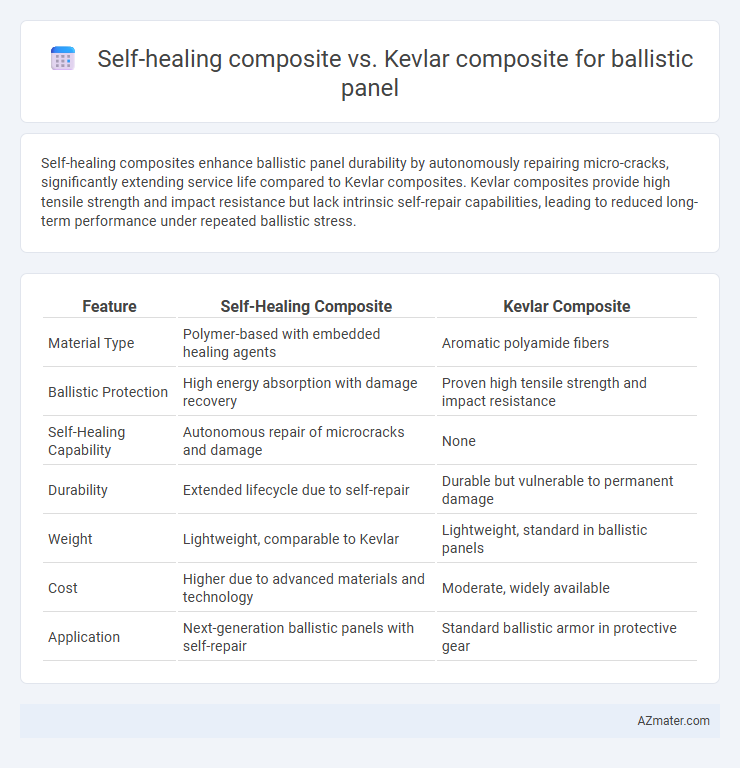Self-healing composites enhance ballistic panel durability by autonomously repairing micro-cracks, significantly extending service life compared to Kevlar composites. Kevlar composites provide high tensile strength and impact resistance but lack intrinsic self-repair capabilities, leading to reduced long-term performance under repeated ballistic stress.
Table of Comparison
| Feature | Self-Healing Composite | Kevlar Composite |
|---|---|---|
| Material Type | Polymer-based with embedded healing agents | Aromatic polyamide fibers |
| Ballistic Protection | High energy absorption with damage recovery | Proven high tensile strength and impact resistance |
| Self-Healing Capability | Autonomous repair of microcracks and damage | None |
| Durability | Extended lifecycle due to self-repair | Durable but vulnerable to permanent damage |
| Weight | Lightweight, comparable to Kevlar | Lightweight, standard in ballistic panels |
| Cost | Higher due to advanced materials and technology | Moderate, widely available |
| Application | Next-generation ballistic panels with self-repair | Standard ballistic armor in protective gear |
Introduction to Ballistic Panels
Ballistic panels are engineered materials designed to absorb and dissipate the energy from projectiles, providing critical protection in body armor and vehicle armoring. Self-healing composites incorporate microcapsules or vascular networks that autonomously repair damage caused by impacts, enhancing durability and extending service life. Kevlar composites, known for their high tensile strength and lightweight properties, remain a benchmark in ballistic protection, offering reliable resistance against bullets and shrapnel.
Overview of Kevlar Composites
Kevlar composites consist of aramid fibers known for exceptional tensile strength and lightweight properties, making them widely used in ballistic panels for effective ballistic resistance. The fibers provide high energy absorption and impact resistance, enhancing protection against bullets and shrapnel while maintaining flexibility. Kevlar composites offer proven durability and reliability in personal body armor and vehicle armor applications, setting a benchmark for high-performance ballistic materials.
Exploring Self-Healing Composite Materials
Self-healing composite materials in ballistic panels offer enhanced durability by autonomously repairing microcracks and damage without external intervention, significantly extending the lifespan compared to traditional Kevlar composites. These advanced materials utilize embedded microcapsules or vascular networks containing healing agents that activate upon impact, restoring structural integrity and maintaining protective performance. Research demonstrates that self-healing composites reduce maintenance costs and improve reliability in high-stress environments, positioning them as a revolutionary alternative to Kevlar for ballistic protection.
Comparison of Mechanical Properties
Self-healing composites exhibit enhanced durability and damage tolerance compared to Kevlar composites, allowing them to recover mechanical properties such as tensile strength and impact resistance after ballistic impacts. Kevlar composites are renowned for their high tensile strength-to-weight ratio and excellent energy absorption, but they lack intrinsic repair capabilities, which limits their lifespan after multiple stress events. The integration of self-healing polymers in ballistic panels improves fracture toughness and fatigue resistance, offering a longer service life and better maintenance of mechanical integrity under repeated ballistic stress.
Ballistic Performance Analysis
Self-healing composites demonstrate enhanced ballistic performance by autonomously repairing micro-cracks and delaminations caused by projectile impacts, thereby maintaining structural integrity and prolonging panel lifespan compared to Kevlar composites. Kevlar composites offer high initial impact resistance due to their tightly woven aramid fibers but lack self-repair capabilities, leading to progressive damage accumulation and reduced protection over repeated impacts. Ballistic performance analysis reveals that self-healing composites exhibit improved energy absorption and damage tolerance metrics, making them a promising alternative for advanced ballistic panel applications.
Durability and Longevity
Self-healing composites in ballistic panels offer enhanced durability by autonomously repairing microcracks and damages, significantly extending the material's lifespan compared to traditional Kevlar composites. Kevlar composites provide high initial impact resistance but lack the intrinsic ability to recover from structural damage, leading to potential degradation over time under repeated stress. The longevity of self-healing composites results from their ability to maintain structural integrity and resist fatigue, making them superior for long-term ballistic protection applications.
Repair and Maintenance Efficiency
Self-healing composites significantly enhance repair and maintenance efficiency for ballistic panels by autonomously restoring microcracks and minor damages, reducing downtime and manual intervention compared to Kevlar composites. Kevlar composites require extensive manual inspection and specialized repair techniques, which can be time-consuming and costly, especially after ballistic impacts. With self-healing technology, ballistic panels maintain structural integrity longer and minimize lifecycle maintenance costs, improving overall operational readiness.
Weight and Flexibility Considerations
Self-healing composites offer significant weight advantages over Kevlar composites for ballistic panels, reducing overall armor mass and enhancing wearer mobility. Their inherent flexibility allows these materials to absorb and dissipate impact energy more effectively without compromising structural integrity. Kevlar composites, while robust, tend to be heavier and less pliable, limiting ergonomic comfort and maneuverability in extended use scenarios.
Cost-Benefit Evaluation
Self-healing composites offer significant long-term cost savings for ballistic panels by reducing maintenance and extending service life through autonomous damage repair, whereas Kevlar composites require frequent inspections and replacements due to irreversible damage. The higher initial cost of self-healing composites is offset by decreased lifecycle expenses and enhanced durability under ballistic impacts. Cost-benefit evaluation favors self-healing composites when operational sustainability and reduced downtime are prioritized in high-performance protective armor systems.
Future Trends in Ballistic Panel Technology
Self-healing composites in ballistic panels offer significant advancements by autonomously repairing micro-cracks, thereby enhancing durability and extending armor lifespan compared to traditional Kevlar composites. Future trends emphasize integrating smart materials and nano-engineered fibers to improve impact resistance and reduce weight, surpassing Kevlar's performance limits. Research is advancing towards multifunctional ballistic panels that combine self-healing capabilities with real-time damage sensing for superior protection in dynamic combat environments.

Infographic: Self-healing composite vs Kevlar composite for Ballistic panel
 azmater.com
azmater.com